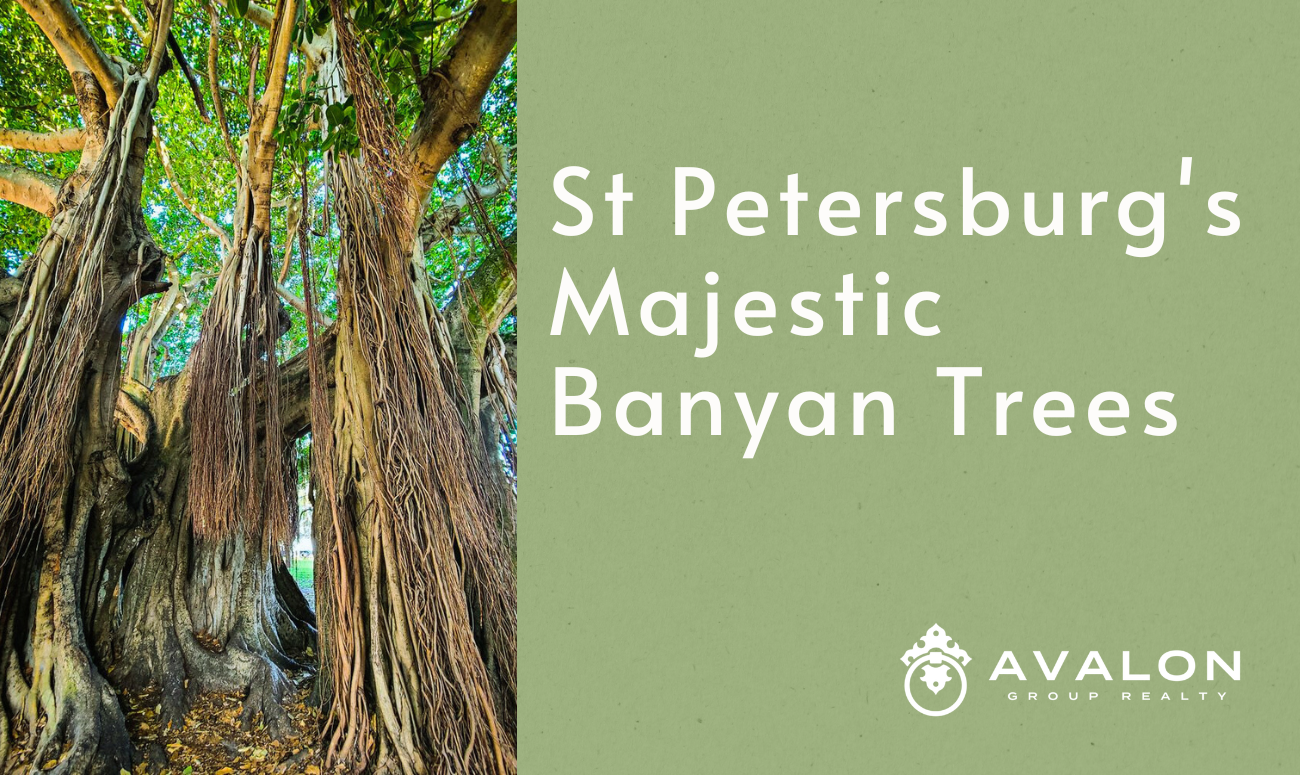St. Petersburg’s Majestic Banyan Trees: Living Landmarks of Beach Drive
As a realtor with Avalon Group Realty in St. Petersburg, Florida, I’ve had the pleasure of introducing countless clients to our city’s unique charms. Among the many attractions that make our area special, few are as instantly captivating as St. Petersburg’s Banyan trees. These living landmarks along Beach Drive are not just trees; they’re a testament to our city’s history, a backdrop for countless memories, and a symbol of the natural beauty that thrives in our subtropical paradise.
St. Petersburg’s Majestic Banyan Trees: The Banyans of Beach Drive: A Brief History
St. Petersburg’s Banyan trees, with their sprawling canopies and intricate aerial root systems, have become synonymous with the city’s waterfront. However, these magnificent specimens are relatively recent additions to our landscape, at least in geological terms.
“The Banyan trees in North Straub Park, which many assume to be centuries old, are actually less than 100 years old,” explains Aaron Hunt, Broker of Avalon Group Realty. “Their rapid growth and impressive size are a testament to St. Petersburg’s ideal climate for these tropical marvels.”
Indeed, the story of how Banyan trees came to Florida is as fascinating as the trees themselves. In 1925, auto tire magnate Harvey Firestone gifted a four-foot-tall Banyan sapling to inventor Thomas Edison at his winter home in Fort Myers. This gesture was part of a broader quest by Edison, Firestone, and Henry Ford to find an alternative source of natural rubber for tire production.
From that single sapling, Banyans spread across South Florida, finding particular success in our corner of the Sunshine State. “St. Petersburg’s Banyan trees are able to thrive this far north thanks to what we call the ‘peninsula effect,'” Hunt elaborates. “The water surrounding Pinellas County creates a temperate, sub-tropical microclimate that allows these Indian natives to flourish.”
Here is a map to North Straub Park in St Petersburg:
A Living Spectacle: The Unique Features of Banyan Trees
St. Petersburg’s Banyan trees are more than just oversized shade providers; they’re living sculptures that captivate residents and visitors alike. Their most distinctive feature is their aerial root system, which creates the illusion of multiple trunks supporting a vast, spreading canopy.
Pam Amante, another realtor with Avalon Group Realty, shares her perspective: “What I love about our Banyan trees is how they seem to defy gravity. The way their roots grow downward from the branches, eventually forming new trunks, is like watching nature’s own architectural project unfold over decades.”
This unique growth pattern is not just visually striking; it also allows Banyan trees to spread laterally to an extraordinary degree. In fact, the largest Banyan tree in the world, located in India, covers an astounding 4.7 acres!
While St. Petersburg’s Banyan trees may not reach quite those proportions, they’re impressive in their own right. The specimens in North Straub Park, directly across from popular eateries like Alto Mare Fish Bar and Annata on Beach Drive, are estimated to be around 90 years old and have grown to dominate the landscape.
The Banyans’ Place in St. Petersburg’s Urban Ecosystem
Beyond their aesthetic appeal, St. Petersburg’s Banyan trees play a crucial role in our urban ecosystem. Their expansive canopies provide much-needed shade in our subtropical climate, creating cool oases for pedestrians and wildlife alike.
Josh Zanow, a realtor specializing in eco-friendly properties, points out the environmental benefits: “These Banyan trees are like natural air conditioners for our downtown area. They help reduce the urban heat island effect, improve air quality, and provide habitats for various bird species. It’s a perfect example of how preserving mature trees can enhance both the livability and sustainability of a city.”
Moreover, the Banyans serve as silent witnesses to St. Petersburg’s evolution. As the city has grown and changed around them, these trees have remained constant, their spreading branches a living link to our past.
St. Petersburg’s Majestic Banyan Trees: A Photographer’s Dream: Capturing the Beauty of St. Petersburg’s Banyan Trees
For both professional photographers and Instagram enthusiasts, St. Petersburg’s Banyan trees offer endless opportunities for stunning images. The interplay of light and shadow through their complex network of branches and aerial roots creates a natural canvas that changes throughout the day.
Yvette Kim, a realtor who moonlights as a landscape photographer, shares her insights: “The Banyans are incredibly photogenic at any time, but they’re particularly magical during the golden hours of sunrise and sunset. The way the light filters through the leaves and casts long shadows can make even amateur photos look professional.”
Kim adds a tip for aspiring photographers: “Don’t just focus on the whole tree. Some of the most interesting shots come from zooming in on the textures of the bark or the patterns created by the aerial roots. And if you’re lucky, you might catch a glimpse of the wildlife that calls these trees home.”
The Banyans as Community Gathering Spaces
Perhaps the most significant role of St. Petersburg’s Banyan trees is as natural community hubs. Their sprawling canopies create inviting spaces for people to gather, relax, and connect with nature in the heart of our urban environment.
“I’ve seen everything from yoga classes to wedding proposals under these Banyans,” recalls Pam Amante. “They’re like nature’s event spaces, providing a backdrop for so many of life’s moments, big and small.”
Children, in particular, seem drawn to the Banyans’ fantastical shapes. Many local families have traditions centered around visits to these arboreal giants. “My kids used to call them the ‘Ballerina Trees,'” laughs Josh Zanow. “Now that they’re older, hide-and-seek among the trunks is their favorite game. It’s wonderful to see how these trees spark imagination across generations.”
Preserving St. Petersburg’s Living Landmarks
As St. Petersburg continues to grow and develop, the preservation of our Banyan trees becomes increasingly important. These trees are not just beautiful; they’re integral to the character and ecology of our city.
Aaron Hunt emphasizes the real estate perspective: “Properties near St. Petersburg’s Banyan trees, particularly those with views of the specimens in North Straub Park, often command a premium. People recognize the value these trees add to our urban landscape.”
However, maintaining these giants requires ongoing effort and expertise. The city’s arborists work diligently to ensure the health of our Banyan trees, monitoring for pests, pruning when necessary, and protecting the root systems from damage.
“It’s a delicate balance,” explains Yvette Kim. “We want people to enjoy these trees, but we also need to ensure they’re protected for future generations. That’s why you’ll sometimes see barriers or signs asking visitors not to climb or carve into the trunks.”
St. Petersburg’s Majestic Banyan Trees: Beyond Beach Drive: Discovering More of St. Petersburg’s Banyan Trees
While the Beach Drive Banyans are the most famous, they’re not the only impressive specimens in St. Petersburg. “There are other massive Banyans by the Mirror Lake Library and in the Bahama Shores neighborhood of South St. Pete,” notes Rob Johnson. “Each has its own character and history, waiting to be discovered by tree enthusiasts and casual observers alike.”
These lesser-known Banyans offer quieter spots for contemplation and nature appreciation, away from the bustle of downtown. They’re also a testament to how well these trees have adapted to various micro-environments across our city.
The Future of St. Petersburg’s Banyan Trees
As we look to the future, the importance of St. Petersburg’s Banyan trees only grows. In an era of climate change and rapid urban development, these trees stand as symbols of resilience and the enduring power of nature.
“We’re fortunate that our predecessors had the foresight to plant and protect these trees,” reflects Aaron Hunt. “Now, it’s our responsibility to ensure they continue to thrive for the next hundred years and beyond.”
Efforts are underway to propagate cuttings from St. Petersburg’s most iconic Banyans, ensuring that their genetic legacy will continue even as the original trees eventually reach the end of their natural lifespans. Additionally, the city’s urban forestry plans include provisions for planting new Banyans in suitable locations, expanding the population of these remarkable trees.
The Science Behind St. Petersburg’s Banyan Trees
While St. Petersburg’s Banyan trees are beloved for their beauty and cultural significance, understanding their biological characteristics adds another layer of appreciation for these magnificent specimens. According to research from the University of Florida, the Banyan tree (Ficus benghalensis) has a fascinating life history and unique attributes that contribute to its impressive stature and potential ecological impact.
St. Petersburg’s Majestic Banyan Trees: Species Overview and Origin
Native to India and the sub-Himalayan region, the Banyan tree has been distributed throughout tropical and subtropical parts of the world, including our own St. Petersburg. “The journey of St. Petersburg’s Banyan trees from their native habitat to our streets is a testament to human curiosity and the adaptability of nature,” notes Aaron Hunt, Broker of Avalon Group Realty.
Life Cycle and Growth
One of the most intriguing aspects of the Banyan’s life cycle is its start as an epiphyte. Seeds, dispersed by birds and other tree-dwelling animals, germinate in the canopy of other trees. From there, they send down roots that eventually envelop and can even kill the host tree. This process explains the complex, multi-trunked appearance of mature Banyans.
Yvette Kim, our resident realtor and nature enthusiast, adds, “Understanding this growth pattern gives you a new appreciation for the Banyans on Beach Drive. What we see is the result of decades of slow, persistent growth – it’s nature’s long-term investment strategy!”
Physical Characteristics
St. Petersburg’s Banyan trees are characterized by their large, evergreen habit and massive fluted trunks. The University of Florida provides detailed information on their physical attributes:
- Leaves: The leaves have a stout, hairy petiole 1.5-8 cm long. The blades are leathery (coriaceous), typically ovate or obovate to elliptic, 8-25 cm long and 6-20 cm broad. They’re glabrous (smooth) above and finely pubescent (hairy) beneath.
- Flowers: Banyans have separate male and female flowers. Male flowers are pedicellate with 2 or 3 tepals, while female flowers are sessile with 3 or 4 tepals. There are also gall flowers, which are pedicellate with 3 or 4 tepals.
- Fruit: The figs (technically a type of fruit) are globose to depressed-globose, 1.5-2.5 cm in diameter, pinkish-red, and hairy.
“These scientific details might seem academic,” says Pam Amante, “but they help explain why our Banyans look and behave the way they do. For instance, those small, reddish figs you might see on the ground? They’re not just dropped fruit – they’re a crucial part of the tree’s reproductive cycle.”
St. Petersburg’s Majestic Banyan Trees: Distribution and Potential Impacts
In Florida, Banyan trees are primarily found in Hillsborough and Miami-Dade counties, with St. Petersburg being a notable exception thanks to our unique microclimate. While beloved in controlled urban settings, it’s worth noting that Banyans have the potential to become invasive in some tropical regions.
Josh Zanow, our eco-conscious realtor, points out, “As much as we love our Banyans, it’s important to be aware of their potential impacts. Their fast growth and extensive root systems can damage infrastructure if not properly managed. That’s why the careful oversight of our city’s arborists is so crucial.”
The root system of Banyan trees is particularly noteworthy. Not only can it spread extensively, but Banyan seeds can also germinate on fenceposts and buildings, potentially causing structural damage over time. This adaptability, while impressive, underscores the need for thoughtful urban planning and tree management.
Balancing Beauty and Management
Understanding the biological characteristics of St. Petersburg’s Banyan trees helps us appreciate not only their beauty but also the challenges and responsibilities that come with hosting these arboreal giants in our urban landscape.
“Knowledge is power when it comes to our Banyans,” concludes Aaron Hunt. “By understanding their nature, we can better appreciate their presence while also taking the necessary steps to manage their growth and prevent any negative impacts on our infrastructure.”
As we continue to cherish St. Petersburg’s Banyan trees, this scientific insight allows us to marvel not just at their outward beauty, but at the complex biological processes that have shaped them over decades. It’s a reminder that our urban forest is a delicate balance of nature and nurture, requiring our ongoing attention and care to thrive in harmony with our growing city.
Conclusion: Living Symbols of St. Petersburg’s Unique Character
St. Petersburg’s Banyan trees are more than just flora; they’re living embodiments of our city’s history, ecology, and community spirit. From their origins as exotic imports to their current status as beloved landmarks, these trees have grown alongside our city, their branches spreading as our community has flourished.
As a realtor, I’ve seen firsthand how features like our Banyan trees contribute to St. Petersburg’s appeal. They’re not just selling points for properties; they’re part of what makes our city a truly special place to live, work, and visit.
So the next time you find yourself strolling down Beach Drive, take a moment to pause beneath the sprawling canopy of St. Petersburg’s Banyan trees. Marvel at their intricate root systems, listen to the rustle of their leaves in the bay breeze, and appreciate the living history that surrounds you. In doing so, you’ll connect with the heart of what makes St. Petersburg not just a city, but a one-of-a-kind community that we’re proud to call home.
If you are looking for a St Petersburg Realtor visit https://avalongrouptampabay.com/




